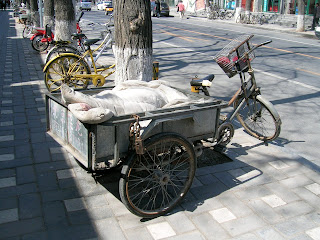Until I started spending every day at the National Library, I spent an insane amount of time at
Cafe Zarah, this fantastic German-owned cafe near Beijing's old drum tower. I can't tell you how many coffee shops here try to make themselves into appealing expat hangouts and just don't quite get it right--the music's too loud, or too poppy, or not loud enough; the staff is too chatty or too standoffish; etc. It's hard to figure out exactly what the problem is, but it's one I have long found frustrating--in Hong Kong I generally went to Pacific Coffee (Starbucks' prime competitor in Asia) rather than to independent cafes for the same reason.
But Zarah just gets it right (and is always packed as a result). Reasonably interesting art. Nice light. Electric outlets. Oh, and maybe the best coffee in Beijing.
One of Zarah's weird charms, however, has nothing to do with the cafe: the street on which it is located (鼓楼东大街)is home to a large and eccentric collection of birds. Okay, there are only two of them, but still.
Bird #1 is a pet goose. Seriously. He has an ID card that he sometimes wears on a string around his neck. His owner, likely a retiree, takes him for a walk up the street every afternoon. This is not a small street--it's like walking a goose, off leash, up College Avenue in Berkeley. But the goose is relatively well behaved. He walks along, flapping his wings occasionally, and stopping for attention when he gets it, which is basically all the time.

Shortly before I took this photo, for instance, this woman was just totally freaking out about the goose, shrieking and giggling at him. The goose used the opportunity to stare at his reflection in the very shiny black car behind him and practice flapping his wings.
Occasionally the goose gets excited and takes off at this sort of wiggling run down the street. At which point his owner also takes off at a wiggling run behind him. Unbelievable.
Bird #2 is a new addition; I first noticed him a couple of weeks ago, hanging in his bamboo cage from a street sign:

This isn't that unusual; I love going to parks in China and seeing old men hanging out with each other and with their birds in bamboo cages. However, when I went up to take a closer look at this bird, I heard someone say "
ni hao" to me in this gruff Beijing accent. I looked around for an old man, but there was no one there! I've seen the bird a couple of times since then but he hasn't talked to me since.

































